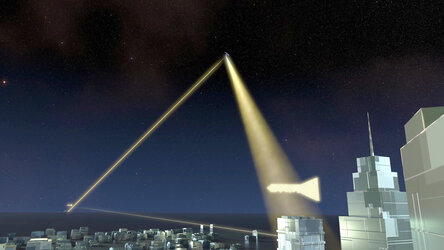Eagle-1
The Eagle-1 satellite will be the first space-based quantum key distribution system to be developed under a partnership between ESA, the European Commission and space companies in Europe.
The satellite will pave the way towards an ultra-secure network that uses quantum key distribution – which uses the unbreakable laws of physics to distribute encryption keys in such a way that any attempt to eavesdrop is immediately detected – to keep information safe, significantly boosting European autonomy in cybersecurity and communications.
Eagle-1 will demonstrate the feasibility of quantum key distribution technology within the EU using a satellite-based system. To do so, the system will build on key technologies developed under ESA’s Scylight programme, with the aim of validating vital components supplied within the EU.
It will demonstrate and validate quantum key distribution technologies from low Earth orbit to the ground and provide valuable mission data for the development and deployment of the European Quantum Communication Infrastructure (EuroQCI), which will be integrated into the European secure connectivity system. It will allow the EU to prepare for a sovereign, autonomous cross-border quantum secure communications network.
The system is being developed by satellite company SES headquartered in Luxembourg, which is leading a consortium of more than 20 European companies.
It will initially use an upgraded optical ground terminal from the German Aerospace Centre (DLR) alongside a new optical ground terminal to be developed by a team from the Netherlands. The Eagle-1 platform satellite from Italian company Sitael will carry a quantum-key payload built by Tesat Spacecom of Germany and will be operated by Luxembourg-headquartered SES. Other ESA Member States involved in the project include Austria, Belgium, the Czech Republic, Italy and Switzerland.
The Eagle-1 satellite is due to launch in late 2025 to early 2026 and will then complete three years of in-orbit validation supported by the European Commission.















 Germany
Germany
 Austria
Austria
 Belgium
Belgium
 Denmark
Denmark
 Spain
Spain
 Estonia
Estonia
 Finland
Finland
 France
France
 Greece
Greece
 Hungary
Hungary
 Ireland
Ireland
 Italy
Italy
 Luxembourg
Luxembourg
 Norway
Norway
 The Netherlands
The Netherlands
 Poland
Poland
 Portugal
Portugal
 Czechia
Czechia
 Romania
Romania
 United Kingdom
United Kingdom
 Slovenia
Slovenia
 Sweden
Sweden
 Switzerland
Switzerland































